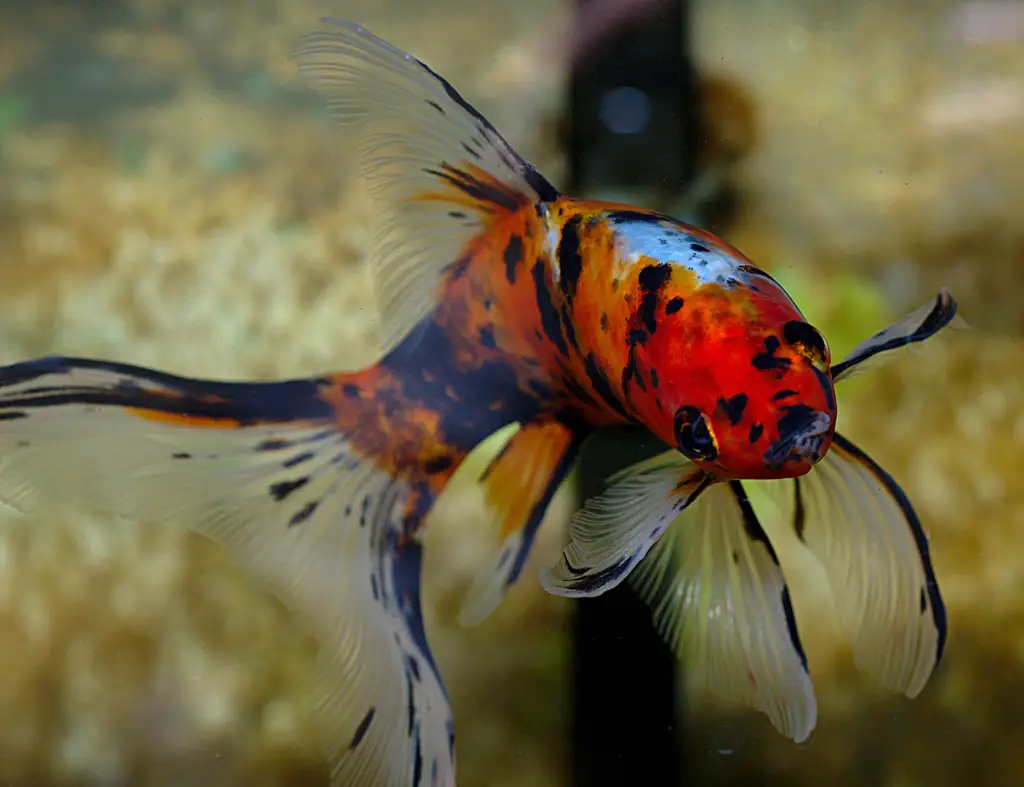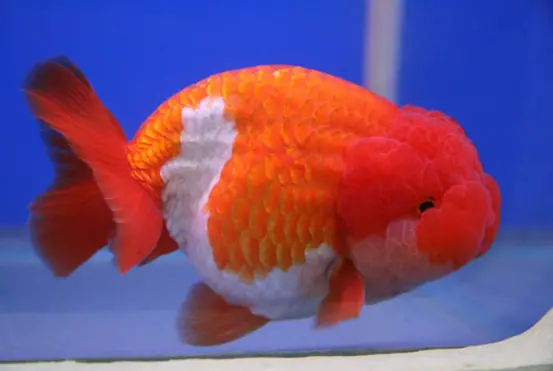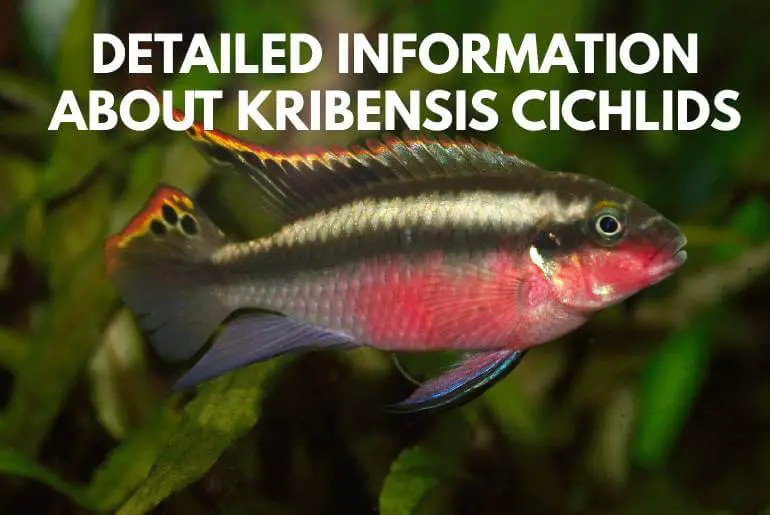Shubunkin Goldfish are the origin of Japan, one of the artificially bred ornamental goldfish species, i.e., strains of telescopic goldfish. Shubunkin is the cheapest bred yet one of the most beautiful fish in the world you can buy. Due to this reason, they are often referred to as “the koi of the poor.”
The Shubunkin is a single-tailed goldfish like its cousin carp and comet, which is distributed worldwide. This fish is so beautiful in its widely spread spotted colors that include shades of red, yellow, black, blue, white, orange, and black with a combination of transparent and metallic scales. Shubunkins with a bluer coloration are considered more valuable.
There are three varieties of shubunkins: American, London and Bristol.
The American shubunkins have a body shape almost identical to the goldfish comet but with slightly larger tails that lean more.
The London shubunkins have a more robust body shape, similar to that of the common shubunkin goldfish, and lack their counterparts’ ostentatious fins.
Bristol shubunkins have moderately large tail fins with rounded edges, which resemble a capital “B.”
The Shubunkin goldfish has become a favorite pond fish among hobbyists, as it is one of the hardest goldfish types. The Shubunkin Goldfish has a slender body like the common Goldfish, but it is distinguished by having red, brown, orange, and yellow colors combined with black spots, the so-called “calico colors.” These colors are found both in the body and the fins. At the same time, the scales of a golden Shubunkin fish are transparent.
The Three Types of Shubunkin Goldfish With Their Differing Characteristics
Varieties of shubunkin goldfish are available throughout the world. Even though some researchers will confirm that there are only two variations and the third is the original. Following are the three types of Shubunkin:
The London Shubunkin Goldfish
This variation of the Shubunkin Goldfish will show the color of the calico and will vary in color combinations. Their bodies are thicker than other Shubunkins. But they are thinner than the pearl scale Fancy shubunkin Goldfish or a Lionhea Fancy Goldfish. The London Shubunkin variation has round fins, and it is similar to other goldfish.
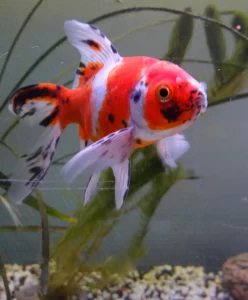
The Bristol Shubunkin Goldfish
The Bristol Shubunkin variety is easier to identify among the three just by its tails. The tail fins of a Bristol Shubunkin are huge, pointed, and bifurcated. Its tail fins will appear to form the capital letter “B” where others do not. The Bristol is also a thin goldfish that will resemble the Comet goldfish.
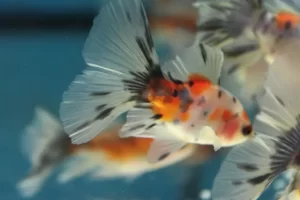
The American Shubunkin Goldfish
Finally, the American Shubunkin Goldfish differs from London and Bristol’s variations mainly due to its tail fins. The tail fins of the American Shuninkin are much longer, more pointed than the other two types of Shubunkin. However, the American (also called Japanese) Shubunkin is also a thin goldfish and can be mistaken for a common calico goldfish.
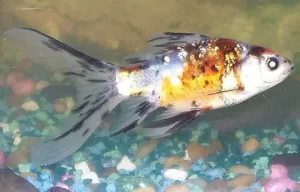
Shubunkin Goldfish Tankmates
So now the question I often hear is: “What can I mix with Shubunkin Goldfish?”
You may be attracted to the goldfish shubunkin by its bright and stained patterns of color that give it the nickname of goldfish. Still, this fish is also a great aquatic pet because of its popular social nature. The shubunkin is a fish of the community that coexists very well with several tank mates.
Koi
Did you know that both the koi and the goldfish are from the family of the carp? Because they share a similar lineage, koi and large goldfish such as shubunkin get along well in a shared environment. Both types of fish are inhabitants of the community, eat the same foods, and socialize well. Besides, koi and shubunkin goldfish look similar and are attractive together in a large aquarium.
Goldfish
Goldfish are the best selections for tankmates for shubunkin. Because the shubunkins are large goldfish, they usually reach 6 to 12 inches in length, and the choice of other colored fish of similar size makes a balanced tank. The comet and the common shubunkin goldfish are excellent options for the tank mates of your shubunkin. Nevertheless, because these beautiful fish are fast, it is best to avoid adding slow goldfish.
Passive fish
Several varieties of passive fish will be able to live longer and healthier in a tank with shubunkin. If you prefer a larger fish, the catfish also gets along well with the shubunkins. Plecos will peacefully share the tank and will even help clean up the environment, excess food, and debris. Avoiding all aggressive fish will help to maintain a good aquarium.
Crustaceans and mollusks
Shrimp, crabs, and snails are good choices for aquarium enthusiasts who want more than just fish in their tanks. These fish are not aggressive, so there is no harm to other fishes. However, if you choose to add crustaceans and mollusks to your tank, choose those that match the size of your goldfish. A large shubunkin can confuse a small snail or crab or fragile shrimp for a snack.
Habitat: Distribution / Background
These wild carps originated in Asia; Central Asia (Siberia). Speaking of fish, according to Statista, the fish is the third and fourth most popular pet in the United Kingdom for the year 2016.
Goldfish is originally from China. By the year 1500, shubunkin goldfish were commercialized in Japan, reaching Europe in the 17th century and America in the 19th century. Asian breeders breed most of the luxury goldfish. We can see the results because of the centuries-long effort in the beautiful colors and shapes of the goldfish of today. Thanks to its unique appearance, the fish has several names that people of different cultures used to call them.
Shubunkin Goldfish Description
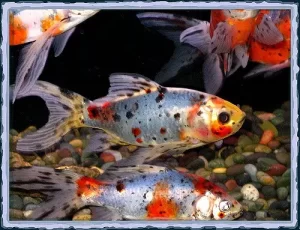 The goldfish Shubunkin is an elongated, flat-bodied variety of goldfish. The head is broad but short, and its body tapers gently from its back and belly to the base of its tail fin (caudal fin), which bifurcates.
The goldfish Shubunkin is an elongated, flat-bodied variety of goldfish. The head is broad but short, and its body tapers gently from its back and belly to the base of its tail fin (caudal fin), which bifurcates.
There are two types of Shubunkins, London and Bristol. The kind of London is very similar to the common shubunkin goldfish, which has the same body and fin shapes. However, the common shubunkin goldfish is larger and has an entirely different coloration: a bright, solid orange. The Shubunkin type of Bristol has a huge tail that is very broad and moderately bifurcated with well-rounded lobes. A proper fishkeeping guide will help you to understand the needs:
Aquarium Size
For now, you know that shubunkins are fast swimmers. The first thing you should think about before creating or buying an aquarium is to make sure that the aquarium is large enough to provide space for the fish to swim in the next few years.
15 gallons is the minimum size you would like to choose you would want to buy for a fish.
Start with a tank of 20 to 30 gallons. For each additional shubunkin goldfish, increase the capacity of the aquarium by 10 gallons.
Aquarium Type
Go for the aquarium that will provide the maximum surface area. The higher the surface area of an aquarium, the less likely it is that the shubunkin fish suffers from oxygen shortage.
The larger surface area means that more water will directly contact the air, thus promoting more oxygen from the air and carbon dioxide from the tank water exchange.
If you prefer to get one with a smaller surface, you can always add an oxygen pump.
The amount of fish per tank
A general rule is 2.54 cm (about one inch) of fish per gallon of water for small fish.
As the shubunkin goldfish grow, you need to expand the capacity of the tank. Maintaining this ratio will avoid problems such as oxygen shortage.
Size and Growth
As the experts always suggest to all aquarists: place less fish than the capacity of the tank can contain.
Mottled goldfish grow at 23 to 46 cm. Always remember to provide enough space for the fish to develop. The bigger the tank, the longer its lifespan will be.
Fish Keeping Difficulty
Shubunkin Goldfish are one of the most resistant species of goldfish. Like any hardy fish, the shubunkin goldfish accepts a wide range of aquarium perimeter, i.e., temperature and water quality. They can do well in an aquarium as well as in a pond as long as the environment in both the tank and the pond is safe and their tank mates are not competitive. Without a proper fishkeeping guide, you will be able to pet the shubunkin goldfish.
Foods and Feeding
Meanwhile, shubunkin is an omnivore; they accept any kind of fish food like fresh, frozen, and flaked foods. To take care of Shubunkin goldfish, maintain the right balance by giving them high-quality flake foods every day. Try feeding brine shrimp (either live or frozen), blood worms, Daphnia, or tubifex worms as a gift once in a while. In general, it is better to feed lyophilized foods instead of live-foods since live food can be contaminated with parasites and bacterial infections.
Let’s look at shubunkin’s diet:
- Type of diet: omnivore
- Flake food: Yes
- Tablet / Pellet: Yes
- Live food (fish, prawns, worms): some of the diet
- Plant foods: some diet
- Meaty Food: some diet
- Feeding frequency: several feeds per day
Aquarium Care
Shubunkin goldfish are hardy fish and easy to maintain in a well-maintained tank. The minimum size recommended for a fish is 15 gallons, making sure that water changes are frequent. Snails can be added to the tank as they reduce the algae and help in keeping the aquarium clean.
Water changes: At least 10% of water change must be done each week. Any variety of goldfish makes a lot of waste, so this will inevitably degrade the water quality. This is the reason you need to change the tank water at least once a week to keep a happy and healthy environment.
For this, 25 Foot – Python No Spill Clean and Fill Aquarium Maintenance System can be a great helping hand. As the length of the 25 feet long, you will not need a bucket to transfer water.
Aquarium configuration
Establishing an aquarium for your shubunkin in a way that keeps your fish happy and healthy is the first step to success. The aquarium’s shape and size are critical and depend on the amount of shubunkin goldfish you are planning to keep. Since these fish produce a lot of fish waste and inhale a lot of oxygen, you need a good filtration system in your tank. Proper filtration, especially biological filtration, is very useful to maintain the quality of aquarium water. Try adding a sump filter to your aquarium system.
Shubunkin goldfish is a cold-water fish and will do better at temperatures between 65 – 72 ° F (18 ° – 22 ° C). The Shubunkin is one of the most resistant varieties of goldfish and can tolerate temperatures a few degrees above the freezing point, provided that the cooling falls only a few degrees per day. A rapid temperature drop can kill them, so you need a heater if you live in a freezing climate. A proper fishkeeping guide will help to establish and configure an aquarium in an effective manner.
You can add some decoration, but make sure all the ornamentation is smooth, with no sharp points or sharp edges. Aquarium plants would be the best option for decorating aquariums for goldfish, but unfortunately, shubunkins are diggers. Consequently, the fish can unroot live plants. Artificial plants are a good substitute, and silk plants are safer than plastic plants.
- Shubunkin goldfish tank size: 15 gallons (57 L) – This shubunkin is very active and very messy. Shubunkin requires a lot of space to swim and excellent filtration to keep it healthy.
- Type of substrate: Any: medium-sized gravel works better.
- Illumination needs: Moderate – normal lighting
- Reproduction temperature: – In the wild, goldfish appear in the spring when water temperatures reach 68 ° F (20 ° C).
- pH range: 6.0-8.0
- Temperature: 65 to 72 ° F (18.3 to 22.2 ° C)
- Hardness range: 5 – 19 dGH
- Brackish: sometimes, the goldfish is a freshwater fish, but they have a certain tolerance to slightly brackish water. Any salinity should be kept low, below 10%, with a specific gravity of less than 1,002.
- Water movement: moderate
Social Behaviors
Shubunkin goldfish are very social animals and thrive in a community. Not only are they a great fish of the community, but they are also excellent scavengers. It is not necessary to add other scavengers or other bottom feeders to the aquarium when you have goldfish. As the most beautiful goldfish, they will thrive in both freshwater and tropical aquariums if there are no aggressive or territorial fish in the aquarium or the pond.
Things you should consider before keeping Shubunkin Goldfish
- Poisonous tankmates: no
- Temperament: Pacific
- Compatible with: any non-aggressive fish
- Same species – conspecifics: Yes
- Peaceful fish: insurance
- Semi-aggressive: Threat
- Aggressive: Threat
- Shrimp, crabs, snails: safe – if not aggressive.
- Plants: Threat: Goldfish will eat many types of aquatic plants. They continuously search for food and may end up tearing up plants they do not eat.
Sex: Sexual differences
During the breeding season, the male will have white spines, called reproductive tubers, in their gill covers and head. A female will have a fatter body as she carries eggs in her belly. It is impossible to distinguish the sex of shubunkin goldfish when they are young or not in the breeding season, but generally, the male is smaller and thinner than the female.
Breeding / Reproduction
Shubunkin Goldfish are egg layers that get fertilized easily under the right conditions. They can be kept in groups of up to five individuals, but they are very social animals and are likely to breed in larger groups as well. The only time that shubunkin goldfish will reproduce in nature is when spring arrives. To engender them in the aquarium, you will have to imitate the conditions found in nature.
Some breeders suggest that you treat them for parasites first. And many breeders will also separate the males and the females for a few weeks before breeding will increase their interest in spawning. For me introducing both the fish into the breeding tank at the same time with some changes in temperature every day worked. Firstly, the temperature can be slowly reduced to around 60 ° F (11 ° C) and then increase the temperature gradually at a rate of 3 ° F (2 ° C) per day until the temperature is between 68 ° and 74 ° F (20 ° -23 ° C). Spawning usually begins when temperatures are between 68 ° and 74 ° F (20 ° -23 ° C).
Feeding protein-rich foods such as shrimp and live worms during this time will also speed up the spawning process. You need to feed them three times a day, in a small amount, try not to overfeed the fish. The leftovers of Uneaten will sink to the bottom and will foul the water. Keep the breeding tank clean with partial water changes of up to about 20% per day.
If you want to learn more about breeding goldfish, please check the article How To Breed Goldfish.
Fish Diseases
In well-maintained aquariums or shubunkin goldfish ponds, the disease of the shubunkin goldfish is preventable. Even so, shubunkin goldfish diseases can occur, and if left untreated, can be fatal. Goldfish is resilient, however, and if dealt with promptly, most will recover completely.
External parasites are most common in shubunkin goldfish, but they are relatively easy to treat and generally not fatal. These include staves, which are flatworms about 1 mm long with hooks around the mouth. They infest the gills or the body of the fish. Another type of parasite is fish lice (Argulus), flattened crustaceans and similar to mites about 5 mm long that adhere to the shubunkin goldfish’s body. Finally, the anchor worms look like threads that come out of the fish.
In the treatment of the fish, it is generally better to move the affected fish to a separate tank without gravel or plants and make regular partial water changes. However, if the disease is evident throughout the main tank, it may be better to do the treatments there. Some medications can adversely affect water quality by destroying beneficial bacteria. And also, keep in mind that you need to remove any chemical media, especially activated carbon, from your tank. Because the carbon will absorb all the medicines you add to your tank, which will make the treatment ineffective.
I have written about various types of goldfish diseases in my previous article. Please check it out for more information on Goldfish Diseases and Their Treatment.
Availability
Shubunkin goldfish are available in fish shops and online, but sometimes they cost a little more than other varieties of goldfish. In different countries, these types of shubunkin goldfish are not available because they are susceptible and therefore are very difficult to transport.

